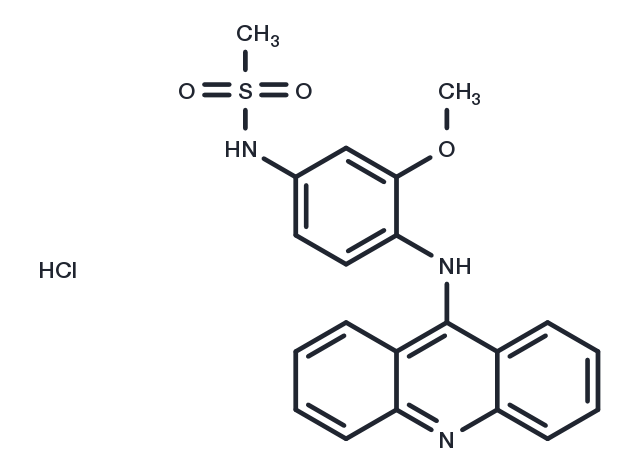Powder: -20°C for 3 years | In solvent: -80°C for 1 year


Amsacrine hydrochloride (acridinyl anisidide hydrochloride) is topoisomerase II inhibitor , is used in the treatment of acute myelogenous leukemia.

| Pack Size | Availability | Price/USD | Quantity |
|---|---|---|---|
| 10 mg | In stock | $ 39.00 | |
| 25 mg | In stock | $ 54.00 | |
| 50 mg | In stock | $ 72.00 | |
| 100 mg | In stock | $ 97.00 | |
| 200 mg | In stock | $ 126.00 | |
| 500 mg | In stock | $ 178.00 | |
| 1 g | In stock | $ 262.00 | |
| 1 mL * 10 mM (in DMSO) | In stock | $ 29.00 |



| Description | Amsacrine hydrochloride (acridinyl anisidide hydrochloride) is topoisomerase II inhibitor , is used in the treatment of acute myelogenous leukemia. |
| In vitro | Amsacrine hydrochloride blocked HERG currents in HEK 293 cells and Xenopus oocytes in a concentration-dependent manner, with IC50 values of 209.4 nm and 2.0 microm, respectively. HERG channels were primarily blocked in the open and inactivated states, and no additional voltage dependence was observed. Amsacrine caused a negative shift in the voltage dependence of both activation (-7.6 mV) and inactivation (-7.6 mV). HERG current block by amsacrine was not frequency dependent.?The S6 domain mutations Y652A and F656A attenuated (Y652A) or abolished (F656A, Y652A/F656A) HERG current blockade, indicating that amsacrine binding requires a common drug receptor within the pore-S6 region[1]. |
| In vivo | In animals treated with different doses of amsacrine (0.5-12 mg kg(-1) ), the frequencies of micronucleated polychromatic erythrocytes increased significantly after treatment with 9 and 12 mg kg(-1) . caused significant suppressions of erythroblast proliferation at higher doses.amsacrine has high incidences of clastogenicity and low incidences of aneugenicity[2]. |
| Cell Research | Voltage-clamp measurements of Xenopus oocytes were performed in a solution containing (in mM): 5 KCl, 100 NaCl, 1.5. CaCl2, 2 MgCl2 and 10 HEPES (pH adjusted to 7.4 with NaOH). Current and voltage electrodes were filled with 3 m KCl solution. For whole-cell patch-clamp recordings from HEK 293 cells, electrodes were filled with the following solution (in mM): 130 K-aspartate, 5.0 MgCl2, 5 EGTA, 4 ATP, 10 HEPES (pH adjusted to 7.2 with KOH). The external solution for these experiments contained (in mM): 137 NaCl, 4.0 KCl, 1.0 MgCl2, 1.8 CaCl2, 10 HEPES, 10 glucose (pH adjusted to 7.4 with NaOH). Amsacrine was prepared as 10 mm stock solution in DMSO and stored at -20℃. On the day of experiments, aliquots of the stock solution were diluted to the desired concentrations with the bath solution. HERG current amplitudes (recorded from Xenopus oocytes) were not significantly altered upon application of 1% DMSO (v v^-1; maximum bath concentration) for 20 min. In addition, DMSO did not affect HERG channel currents recorded from HEK 293 cells at concentrations up to 0.3% (maximum bath concentration in this study: 0.1% DMSO)[1]. |
| Synonyms | acridinyl anisidide hydrochloride, m-AMSA hydrochloride |
| Molecular Weight | 429.92 |
| Formula | C21H20ClN3O3S |
| CAS No. | 54301-15-4 |
Powder: -20°C for 3 years | In solvent: -80°C for 1 year
DMSO: 4.3 mg/mL (10 mM)
You can also refer to dose conversion for different animals. More
bottom
Please see Inhibitor Handling Instructions for more frequently ask questions. Topics include: how to prepare stock solutions, how to store products, and cautions on cell-based assays & animal experiments, etc.
Amsacrine hydrochloride 54301-15-4 Autophagy DNA Damage/DNA Repair Topoisomerase inhibit acridinyl anisidide hydrochloride Inhibitor acridinyl anisidide Amsacrine Hydrochloride Amsacrine acridinyl anisidide Hydrochloride m-AMSA Hydrochloride m-AMSA hydrochloride m-AMSA inhibitor
